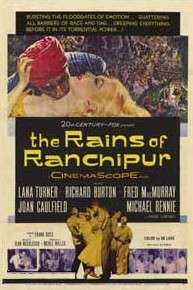The Rains of Ranchipur
| The Rains of Ranchipur | |
|---|---|
 Original movie poster | |
| Directed by | Jean Negulesco |
| Produced by | Frank Ross |
| Written by |
Merle Miller Louis Bromfield (novel) |
| Starring |
Lana Turner Richard Burton Fred MacMurray Joan Caulfield Michael Rennie |
| Music by | Hugo Friedhofer |
| Cinematography | Milton R. Krasner |
| Edited by | Dorothy Spencer |
| Distributed by | 20th Century Fox |
Release dates |
|
Running time | 104 minutes |
| Country | United States |
| Language | English |
| Budget | $2.9 million[1] |
| Box office | $2.6 million (US)[2] |
The Rains of Ranchipur is a 1955 American drama film made by 20th Century Fox. It was directed by Jean Negulesco and produced by Frank Ross from a screenplay by Merle Miller, based on the novel The Rains Came by Louis Bromfield. The music score was by Hugo Friedhofer and the cinematography by Milton R. Krasner.
The film stars Lana Turner, Richard Burton, Fred MacMurray, Joan Caulfield and Michael Rennie with Eugenie Leontovich.
Made in color, Cinemascope, and four-track stereophonic sound, the film is a remake of the black-and-white film The Rains Came (1939), also made by Fox, directed by Clarence Brown and starring Tyrone Power and Myrna Loy. However, the 1955 film changes the novel's ending.
Plot
In India to purchase some horses, British aristocrat Lord Esketh and his wife, Edwina, come to the town of Ranchipur at the invitation of the elderly Maharani. Their marriage is an unhappy one and Lord Esketh announces his intention to return to England and begin divorce proceedings. The spoiled, insensitive Edwina scoffs at this.
She renews in Ranchipur an acquaintance with a former lover, Tom Ransome, now a dissolute alcoholic. She also meets and attempts to seduce a distinguished Hindu physician, Dr. Rama Safti, a decent man who is the elderly Maharani's personal choice to succeed her someday.
Safti at first resists, but ultimately succumbs to Edwina's charms and falls hopelessly in love with her. Lord Esketh becomes aware of this, but Safti saves him from a man-eating tiger during a safari. Safti admits his love for Edwina to Lord Esketh, who is now sympathetic toward this good man's plight.
Ransome feels the same way, warning Edwina to stay away from Safti, a friend he admires. Edwina similarly falls into disfavor with the Maharani, who explains that Safti has been raised to lead a pure life and that Edwina is unworthy of him.
Ranchipur suddenly is ravaged by a natural disaster, an earthquake and flood. Dr. Safti is so busy saving lives that he cannot personally care for Edwina, who has fallen ill. Ransome looks after her as well as for young Fern Simon, who has declared her love for him. When a dam is exploded by dynamite and as a result the flood waters recede, it is Dr. Safti who reveals that Ransome is the one who risked his personal safety to save the people of Ranchipur.
Edwina tries to explain to the Maharani that her love for Safti has become true, so much so that she will make the sacrifice of leaving him for his own good. She drives away from Ranchipur with her husband.
Cast
- Lana Turner as Lady Esketh
- Richard Burton as Dr. Rama Safti
- Fred MacMurray as Tom Ransome
- Michael Rennie as Lord Esketh
- Joan Caulfield as Fern Simon
- Eugenie Leontovich as the Maharani
Production
The film was a remake of The Rains Came (1939), which had been co-written by Philip Dunne. Dunne later wrote about the remake:
All I ever contributed to the remake was the title: The Rains of Ranchipur. The writer and producer, both friends of mine, tactlessly, unkindly and repeatedly informed me that their script was infinitely superior to the one Julien Josephson and I had written, which they dismissed as too old fashioned and corny for our purposes. They decided not to use any of it, and in fact didn't. Unfortunately for them, in the process they eliminated the most important event of all, the naughty lady's death, thereby violating the very essence of author Bromfield's original design. They turned a noble tragedy, corny or not, into a mere romantic interlude and thus achieved what they deserved: a resounding flop.[3]
Criticism
Film scholar Richard Dyer has argued that The Rains of Ranchipur, like a number of other contemporary movies, are orientalist, besides "ultra-colonialist" and "white supremacist", and that the function of those movies is to "attempt to recapture the supposed scrutiny of an inequitable past".[4]
See also
References
- ↑ Solomon, Aubrey. Twentieth Century Fox: A Corporate and Financial History (The Scarecrow Filmmakers Series). Lanham, Maryland: Scarecrow Press, 1989. ISBN 978-0-8108-4244-1. p250
- ↑ 'The Top Box-Office Hits of 1956', Variety Weekly, January 2, 1957
- ↑ Dunne, Philip (1992). Take Two: A Life in Movies and Politics. pp. 239–240.
- ↑ Dixon, Wheeler Winston (1999). "Rev. of Dyer, White". Film Quarterly. 52 (4): 62–63. doi:10.1525/fq.1999.52.4.04a00220. JSTOR 1213790.